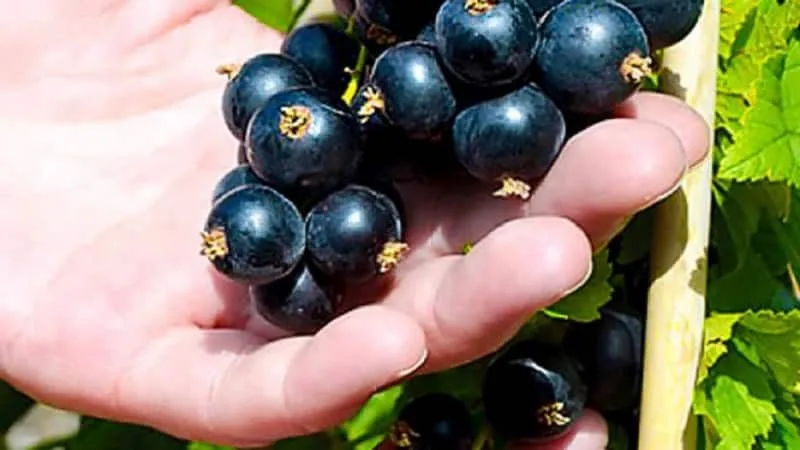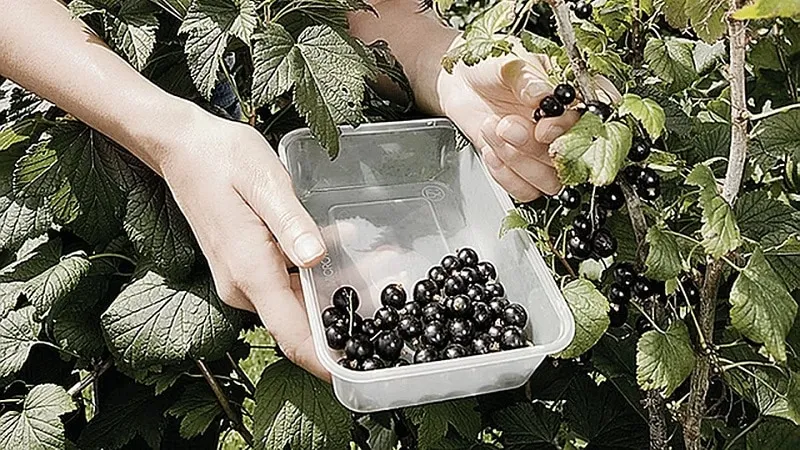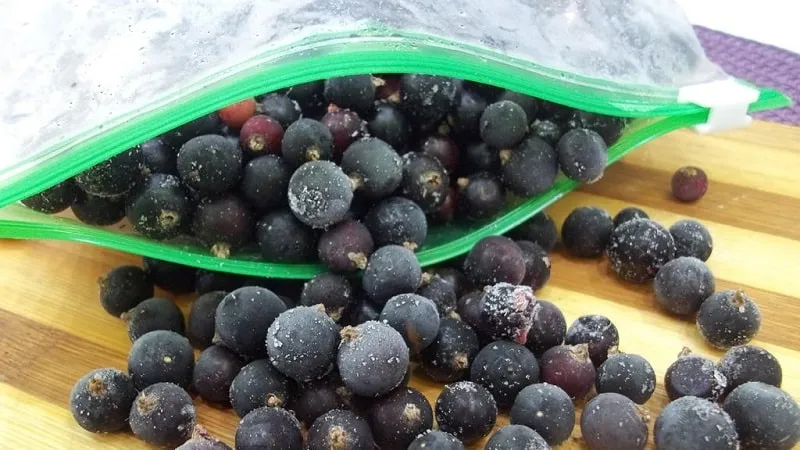In European gardens, blackcurrants are among the most popular berries. The shrub is hardy and grows almost everywhere. There are countless cultivated varieties: tart, sweet with a subtle tang, small berries, and those over a centimetre in diameter, early varieties ready by June and late ones ripening by mid-August. These delicious, vitamin-rich berries can be eaten straight from the bush, processed, or preserved for the next season by drying or freezing. Here’s how and when to harvest blackcurrants to maximise their benefits.
Table of contents
How to Determine Berry Ripeness
Begin harvesting only when you’re sure the berries are ripe. Unripe fruits are usually firm, sour, and green or brown in colour.
When the berries turn deep black, sometimes with a purple hue, the clusters they grow on shift from emerald to brown, the fruits detach easily from their stems, and the currants fall at the slightest touch – it’s time to harvest.
Good to know! A matte or glossy skin depends on the variety. Don’t use it to judge the berry’s health or ripeness.
Beginner gardeners often ask whether unripe blackcurrants can be picked. Experts say yes, but underripe berries lack nutritional value and aren’t suitable for winter preserves. They’re also not recommended for people with sensitive digestive systems.
Harvesting slightly underripe berries makes sense in one case: if long-distance transport is planned. In a cool place, blackcurrants will ripen fully in 5–7 days.

When to Harvest
All garden blackcurrant varieties fall into three categories: early, mid-season, and late.
Early varieties bloom in early May and produce ripe berries by mid-June. However, in northern Europe, where the gardening season starts in early May and spring frosts are common, these varieties are impractical. Early blackcurrants are best suited to southern regions.
Mid-season and mid-late varieties are the most popular across Europe. They thrive in all agricultural climate zones. Mid-season shrubs bloom in late May, when frost damage is rare. By mid-July, gardeners can start harvesting.
Mid-late varieties bloom and fruit about a week later than mid-season types.
Late varieties are ideal for northern regions, where frosts can occur even in early June. These currants bloom in late May or early June, with berries ripening by early August – sometimes even mid-month. Their extended growing period is thought to enhance their vitamin content.
How to Harvest Blackcurrants Properly
Unlike red or white currants, blackcurrants ripen unevenly. So don’t try to strip the entire bush at once. Start harvesting when most berries are ripe.
Remember! Blackcurrants overripen quickly, especially in wet weather, leading to splitting and dropping. Harvest promptly – don’t spread the task over weeks.
If berries detach easily from their stems, there’s no need to pick them in clusters. Contrary to popular belief, individually picked currants won’t crush or leak juice. After harvesting, refrigerate them immediately or store them in a cool, shaded spot.
Cluster harvesting has two advantages: it’s faster and protects berries during transport. But there’s a downside: before processing, you’ll need to clean the berries from debris – extra time and effort.
Some gardeners use a quick-harvest method: spread fabric or plastic under the bush and pick with both hands. Once done, transfer the berries from the sheet to a bucket. This method requires sorting before preserving.

Preparing for Long-Term Storage
After harvesting, eat or process blackcurrants quickly. Ripe berries stay fresh for up to 5 days in the fridge or about a day at room temperature. If stored longer, they mould, ferment, and spoil.
Before preserving, remove leaves, crushed berries, and debris. This is usually done by hand, but for large quantities, try these methods:
Gently transfer currants to a wide bowl, cover with cold water, and swirl lightly. Debris floats to the surface – pour off the water. Then, detach berries from stems by hand.
A fork makes stem removal easy: slide clusters between the tines, and the berries fall off. This works best with firmer berries. Handle carefully to avoid crushing them.
Note! Stems left on berries don’t affect the taste or shelf life of preserves.
Another sorting method: tilt a cutting or washboard at 60–70° over a tray. Pour berries onto the slope – they’ll roll down while debris stays. Brush off debris between batches.
Always rinse currants gently in cold water before use.
Proper Storage Methods
Blackcurrants fruit only in summer. To preserve their vitamins and flavour, store them correctly.
Here are several long-term storage techniques:
Freezing
Freezing and storage guidelines:
- Spread dry berries in freezer bags and place in the freezer;
- The colder the freezer, the longer they last;
- In modern freezers (-18°C or lower), berries keep until next season;
- To thaw, move the bag to the fridge’s top shelf for gradual defrosting – this maintains texture.

Drying
Drying garden berries is simple:
- In hot weather, dry them outdoors in a breezy spot;
- In rainy summers, use an oven: spread berries thinly on a tray and dry at 200–230°C for 2–3 hours with the door slightly open;
- Ensure they’re fully dry, or they’ll rot;
- Store dried berries in glass jars, cardboard boxes, or linen bags;
- Keep in a dry room at room temperature for up to a year.
Making Delicious Preserves
Here are some popular blackcurrant winter recipes:
Fresh Blackcurrants with Sugar
Ingredients:
- Blackcurrants – 1 kg;
- Sugar – 2 kg (reduce to 1.5 kg if storing in a cool place like a cellar).
Method:
- Wash and dry the berries.
- Blend or mince them.
- Mix with sugar. Warm slightly to dissolve sugar faster.
- Pour into sterilised jars, top with a sugar layer, and seal.
Jelly-Like Jam
Ingredients:
- Blackcurrants – 1 kg;
- Sugar – 1 kg;
- Water – 1 cup.
Method:
- Combine water and sugar.
- Heat gently, stirring until sugar dissolves.
- Add washed berries to the boiling syrup.
- Simmer for 10 minutes, skimming foam.
- Pour into sterilised jars and seal.
- Invert jars and wrap in a blanket until cool.

Blackcurrant Liqueur
Ingredients:
- Blackcurrants – 0.5 kg;
- Vodka – 0.5 l;
- Sugar – 250 g;
- Water – 1 cup.
Method:
- Mash berries and place in a glass jar.
- Add vodka and infuse for a week.
- Shake occasionally to prevent clumping.
- Strain after 7 days.
- Press berries firmly for richer flavour.
- Boil sugar and water into a syrup, then mix with the infusion.
- Store the liqueur in a cool place.
Tips from Experienced Gardeners
Handy advice from seasoned blackcurrant growers:
- Harvest in the morning after dew dries or in the evening – berries picked in heat spoil faster.
- For fresh eating, pick in any weather. For storage, choose dry, sunny days.
- Use clean, dry containers for harvesting.
- Avoid transferring berries unnecessarily to prevent bruising.
Conclusion
Harvesting and processing blackcurrants takes time and effort. Follow these simple rules: start picking before the entire bush ripens; avoid harvesting in heat or rain – opt for dry, mild mornings or evenings; use clean, dry containers; and minimise handling. Properly harvested currants will store well, delighting your taste buds and boosting your health year-round.







